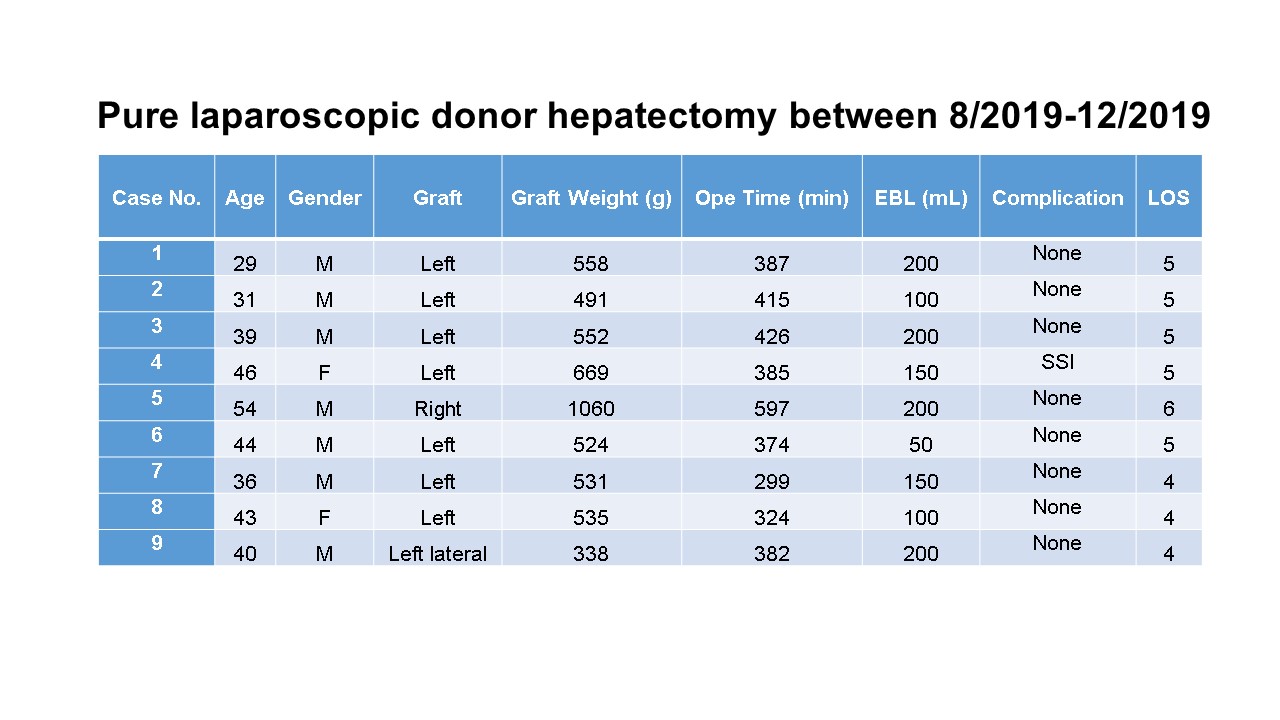Initial Case Series of Pure Laparoscopic Donor Hepatectomy in Cleveland Clinic
Cleveland Clinic Foundation, Cleveland, OH
Meeting: 2020 American Transplant Congress
Abstract number: D-120
Keywords: Laparoscopy, Living donor
Session Information
Session Name: Poster Session D: Liver: Living Donors and Partial Grafts
Session Type: Poster Session
Date: Saturday, May 30, 2020
Session Time: 3:15pm-4:00pm
 Presentation Time: 3:30pm-4:00pm
Presentation Time: 3:30pm-4:00pm
Location: Virtual
*Purpose: Techniques for laparoscopic liver resection (LLR) have been developed over the two decades, and its advantage in less postoperative pain and early recovery are widely accepted. Although the benefits of LLR are most suitable in the living donor hepatectomy, adoption of LLR to living donor hepatectomy has been restricted, especially in the United States, due to concerns about donor safety. This study aimed to report our initial experience of laparoscopic living donor hepatectomy (LDH) in Cleveland Clinic.
*Methods: Between August 1, 2019, and December 6, 2019, 11 living donor hepatectomy were performed. Among the 11 cases, 9 LDH were performed (81.8%). All cases were performed by standardized approach. The donor was placed in a supine position with the surgeon between the legs. First assistant and the scopist stood on the left side of the donor. Four 12mm trocars and one 5mm trocar were placed according to patient body size and liver cutting plane. A 10 mm flexible 3-D scope was used. Liver parenchymal transection was performed using an ultrasonic dissector and ultrasonic aspirator. Bipolar forceps and sealer were used for hemostasis. The major vessels were transected using a vascular stapler. Bile duct transection line was decided based on Indocyanine green fluorescence imaging. Liver graft was extracted from Pfannenstiel incision. The donor characteristics, intraoperative data, and postoperative outcomes were summarized.
*Results: Among the 9 cases of LDH, 7 cases were full left lobe with caudate lobe graft, 1 case was right lobe graft, and 1 case was left lateral segment graft. The detail data of each case are shown in Table 1. No case required blood transfusion nor open conversion. One out of nine donors had a postoperative complication (surgical wound infection). All donors were discharged within POD 6.
*Conclusions: The indication of laparoscopic approach and surgical video with detail procedures will be presented.
To cite this abstract in AMA style:
Sasaki K, Aucejo F, Fujiki M, Uso TDiago, Eghtesad B, MIller C, Quintini C, Hashimoto K, Kwon CD. Initial Case Series of Pure Laparoscopic Donor Hepatectomy in Cleveland Clinic [abstract]. Am J Transplant. 2020; 20 (suppl 3). https://atcmeetingabstracts.com/abstract/initial-case-series-of-pure-laparoscopic-donor-hepatectomy-in-cleveland-clinic/. Accessed November 25, 2025.« Back to 2020 American Transplant Congress

